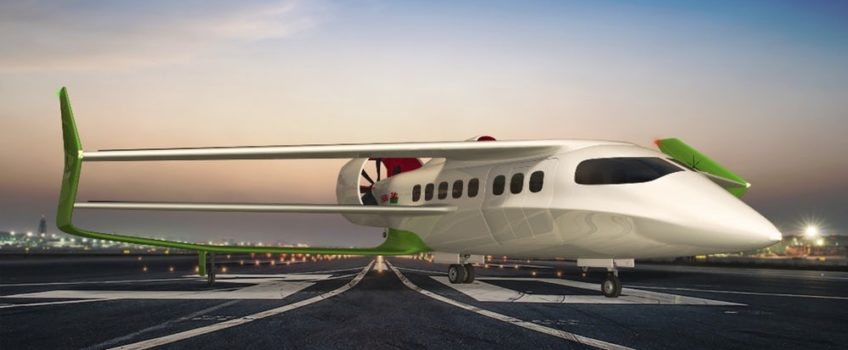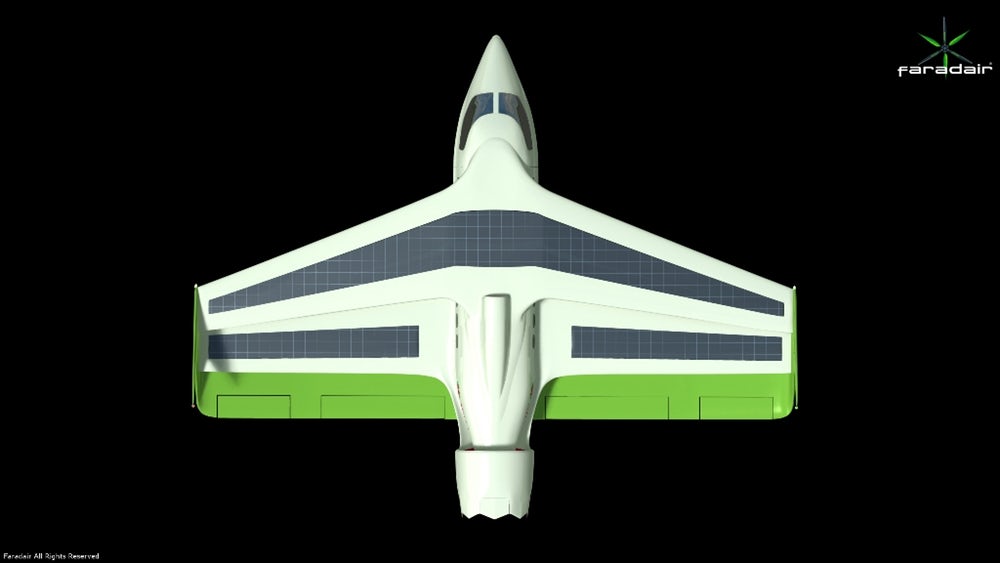
Img credit: Faradair
Considered as the world’s first real hybrid airplane, the Faradair BEHA (Bio-Electric-Hybrid-Aircraft) is a “triple box-wing design concept”. It’s a clever combination of electric motors and a bio-diesel engine fitted with several energy saving and recovery technologies. This includes solar panels on all flight surfaces and high-lift, low-speed flight capabilities.
The concept was first realised back in 2014 when UK firm, Faradair, proposed a Bio-Electric-Hybrid-Aircraft (BEHA). They have now announced that their plans are in place for a small BEHA airliner. The hybrid aircraft could be ready to take flight in 2025 as one of the world’s most environmentally friendly airplanes.
How Does The Bio-Electric Hybrid Aircraft Work?
As mentioned earlier, the original concept BEHA_M1H features “triple box-wing” design for enhanced lift. Coupled with a carbon-composite-body, this 18-seat hybrid aircraft should be able to take off and land using less than 300 meters (984 ft). This opens up numerous possibilities as it can be used to access smaller airports with shorter runways.
At the rear, two contra-rotating prop fans are housed within an acoustic duct providing vectored thrust. The aim is to reduce noise during take-off to less than 60 dba compared to a normal jet engine producing around 140 dba.
As the name of the hybrid aircraft suggests, power comes from a combination of batteries and bio-diesel. While the batteries power its electric motor during take-off and landing, a 1,600-hp turboprop bio-diesel engine will generate power for cruising.
Interesting Read: ‘Hybrid Electric Plane A Future Revelation’
What’s The Performance Like?
The twin electric fan motors appear similar in design to those used on the Airbus E-Fan electric aircraft. Each motor will produce 200 hp (150 kW) working in unison with the powerful bio-diesel engine which will charge the batteries while cruising.
That’s not all as the hybrid aircraft also gets additional power recharging from solar panels fitted on top of the wings. This will seriously increase the overall performance and flying time. Inspiration for the BEHA came from the de Havilland Dragon Rapide, an iconic British design dating back to the 1930s.

From Passengers To Cargo In 15 Minutes
Looking beyond a small passenger jet, the BEHA_M1H will also be able to haul cargo. According to the company, ground crews can apparently replace the seats with three of Faradair’s LD3 cargo containers in 15 minutes. They say that the M1H hybrid aircraft will be capable of carrying a combined load of 5 tonnes (5.5 US tons).
Depending on the configuration, early reports suggest that it could reach a cruising speed of over 200 knots (230 mph/370 km/h), and possibly a range exceeding 1,000 nautical miles (1,852 km).
Advanced Safety Features
This futuristic hybrid aircraft will have numerous active and passive safety features. It includes a ballistic parachute recovery system, high-impact crash protection which is actually modelled on Formula One motor racing technology. In addition, it can run on fewer of the engines while also featuring a high-efficiency glide capability. This, of course, allows the hybrid aircraft to fly unpowered for longer in the unlikely event of total engine failure.
Remote Controlled Piloting
While that in itself is an impressive list, the most interesting of all is a remote control system. Faradair has plans to add this to the BEHA should the pilot be unable to fly. In such an event, a pilot on ground can easily take control and safely land the aircraft.
Even though no airlines have approved such a system anywhere, the company believes that the ability to remotely control an aircraft in emergencies would greatly boost passenger confidence and safety.
Final Thoughts From Faradair
Neil Cloughley, Managing Director of Faradair Aerospace Limited said: “Markets will be opened up as this lightweight, state-of-the-art, carbon fibre, high-lift designed aircraft will negate night flight restrictions and pollution concerns. It’s truly radical and futuristic design aims to follow in the footsteps of other great aviation achievements by becoming a game changing aircraft that helps transform aviation as we know it today.”
He continued by saying that, “the BEHA M1H variant, multi-role aircraft, will allow operators the ability to provide viable air transport services including; scheduled commuting flights, flight training and charter by day and the ability to use the quiet flight characteristics and payload capability for cargo operations at night. Our order book is now open and we look forward to working with potential customers and airport operators, as we begin the build of our first demonstration prototypes later this year, intended for flight trials by 2022.”
More About PRV Engineering
If you liked this article, please follow our blog for more interesting stories on engineering, manufacturing and technology. Get in touch with PRV Engineering through our website or chat with us on Twitter, Facebook and LinkedIn.
One comment
Leave a Comments Cancel Reply
This site uses Akismet to reduce spam. Learn how your comment data is processed.


 Mail:
Mail: 




[…] The UK’s very own Bio-Electric Hybrid Aircraft, the BEHA_M1H […]